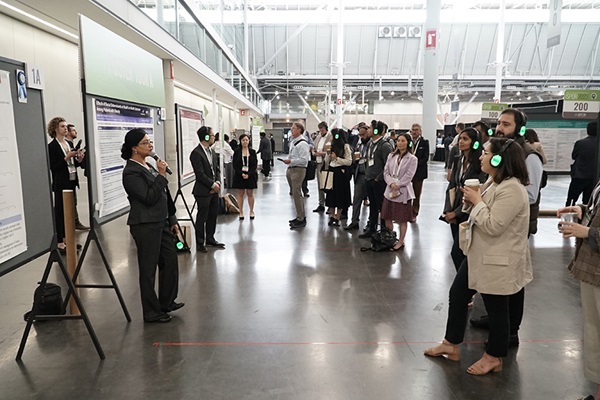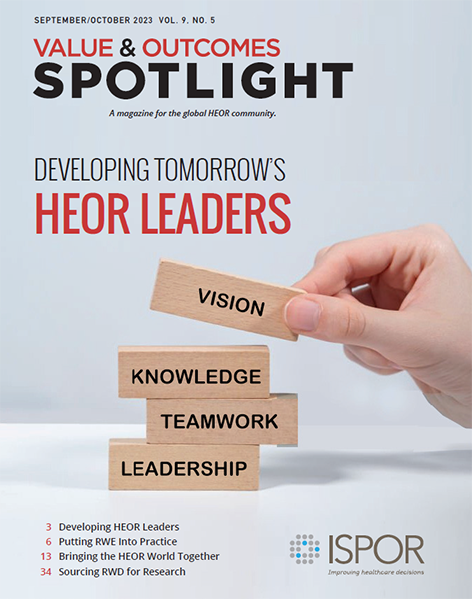ISPOR 2023: Bringing the HEOR World Together
Christiane Truelove
ISPOR’s annual conference, which took place in Boston, Massachusetts in May, drew more than 4500 delegates from 71 countries, hosted more than 450 speakers across 130 sessions, and presented 180+ hours of content. The main themes at the conference were affordability and innovation, real-world evidence, and artificial intelligence in healthcare. In real-world evidence, discussions focused on reproducibility, transparency, governance, and data quality, especially by healthcare regulators and policy makers.
The highlights and commentary on the content and activities of ISPOR 2023 events in Boston are summarized here and are also available to all ISPOR members via the ISPOR 2023 Key Insights Session.

Affordability and Implications of the Inflation Reduction Act
Samantha Roberts, DPhil, MBA, (National Institute of Health and Care Excellence, United Kingdom and conference co-chair), moderated the first plenary session at the conference, “Global Focus on Affordability and Inward Investment: What Does It Mean for HEOR?” Roberts was joined by the following panelists: John M. O’Brien, PharmD, MPH (National Pharmaceutical Council); Michael Drummond, MCom, DPhil (University of York); and Meena Seshamani, MD, PhD (Centers for Medicare & Medicaid Services).
Besides discussing value pricing and affordability across countries, the panelists took a deep dive into the provisions of the Inflation Reduction Act, addressing its effects on consumer out-of-pocket spending and factors relating to value that may be brought into Medicare price negotiations, and how all this may affect incentives for innovation.
Roberts pointed out that health and care systems around the world “are struggling with affordability of medicines. Whether we like it or not, drug costs are a big part of that affordability issue.” She predicts that changes are coming. “Governments are going to introduce policies to try to tackle this and we, as an HEOR community, can’t sit on the sidelines and criticize those policies. We need to be part of the effective implementation of these policies and play an active role in considering the intended and unintended consequences of their implementation. The call is for this community to engage with governments and payers—curiously, creatively—to find new approaches and solutions together.”
Laura T. Pizzi, RPh, PharmD, MPH, chief science officer at ISPOR, characterizes the Inflation Reduction Act as “probably the number one topic of this meeting,” as the act has pushed HEOR into mainstream conversations. “This is a pivotal moment for our science,” Pizzi said.
This conversation on affordability will center on value. “Value is what we do in HEOR. We specialize inthe science of measuring it. We definitely want the conversation to be about value,” Pizzi said.
Currently, those making value determinations about new drugs are dealing with a limited amount of data. Because of this, the Inflation Reduction Act does not provide for drug price negotiation until 9 years post launch. “By 9 years out, we need to strive as a field to have sufficient evidence to inform that negotiation process,” Pizzi said. “That is a major, major change in how the industry operates and how our field has operated with decision making. It’s really exciting and presents so much opportunity for us.”
Advancements in Real-World Evidence
William Crown, PhD, distinguished research scientist, Brandeis University, United States and ISPOR 2023 RWE Summit program committee member, commented on the “packed” conference agenda. For him, one important takeaway was the report out on the US Food and Drug Administration-funded RCT-DUPLICATE study, which examined 32 clinical trial emulations attempting to mimic the inclusion-exclusion criteria of trials, the endpoints, and the treatments that were studied in trials with observational data.
“The degree of agreement between these observational studies and the randomized trials was really pretty impressive,” Crown said. “It was over 90%. This suggests that we’re always going to need randomized trials, especially for studying new treatments where there are no data on them in these observational databases. But it also shows that in cases where we can’t do trials (eg, in the middle of a COVID pandemic) where we’re trying to figure out what treatments work and what treatments don’t, observational studies can allow us to get reliable answers without the time-consuming process of recruiting patients and waiting for outcomes so that we can act more quickly.”
Another takeaway from the RCT-DUPLICATE study was around issues of transparency. “It’s really important that when these observational studies are being done that people understand that there isn’t a cherry-picking of the results,” he said, pointing to the guidance released by ISPOR and the International Society for Pharmacoepidemiology (ISPE) in 2022, “HARmonized Protocol Template to Enhance Reproducibility (HARPER).” The guidance came out of an ISPOR/ISPE joint task force to develop a uniform template to help collect real-world data and conduct real-world evidence studies. The report describes how to design an observational study to get a reliable estimate from it, “because it’s not only the data, but it’s also how you design the study,” Crown said. “When you have good data and good design, you can get really close to the same results you would have gotten had you done a time-consuming and expensive clinical trial.”
Causal Inference and Electronic Health Records
Conference Co-Chair Sebastian Schneeweiss, ScD (Brigham and Women’s Hospital) moderated the third plenary, “Issues and Solutions When Estimating Treatment Effects Using US Electronic Health Record Data,” which looked at several issues that arise when performing causal inference studies with electronic health record data and presented potential solutions in each case. Richard Wyss, PhD (Brigham and Women’s Hospital) discussed methods for adjusting for confounders and ultra-high dimensional covariant settings. Jeremy Rassen, ScD (Aetion Inc) gave an example of how submitting an active comparator studying design, instead of a no-treatment comparative design, helped reduce bias. Rebecca A. Hubbard, PhD (Hospital of the University of Pennsylvania) talked about informative presence bias in electronic health record data. Janick Georg Weberpals, PhD (Brigham and Women’s Hospital) reviewed diagnosing patterns and missing data.
According to Schneeweiss, “The session was driven by the underlying data that become available, and as more and more electronic health record data become available, new methods are developing that make optimal use of these real-world, electronic health records. We have learned a lot about claims data in the past 25 to 30 years. Now, we’re in a new era of learning how to analyze electronic health record data and a lot of issues are coming up. As there is quite a bit of heterogeneity in these data, it is important to realize that the way we as physicians practice medicine has direct implications of the data structures and on how we analyze the data. And that needs to be factored into the analytic methods that we are developing.”
Pizzi points out that HEOR methods evolved “in an era where we didn’t have enough data.” The old way of choosing a comparison cohort would be that you would look at patient demographics, you would look at their treatment characteristics, you would look at their disease severity, and you could do a reasonable job matching your treatment in comparison groups that way,” Pizzi said. “But with real-world evidence, you still might have some imbalances that exist despite doing that.”
Artificial Intelligence in the Physician’s Office
Conference Co-Chair Mitchell Higashi, PhD (GENEDx) moderated the second plenary session, “AI Wants to Chat With You: Accept or Ignore?” The session featured Blythe Adamson, MD, MPH (Flatiron Health); Jacqueline Shreibati, MD (Google Health); David Sontag, PhD (Massachusetts Institute of Technology); Guillermo A. Cecchi (IBM Research and National Institute of Health’s Advancing Medicines Partnerships–Schizophrenia); and Mary Beth Ritchey, PhD, MSPH, BSN (FDA/CDRH/Office of Product Evaluation and Quality/Office of Clinical Evidence and Analysis).
According to Higashi, “The promise of using artificial intelligence and large language models is that we have this vast universe of unstructured data.” He estimates that currently, HEOR experts only work with 20% of the available data, which exist primarily as structured claims data and structured physician notes.
“All the data captured on devices (ie, your conversations, often your informal conversations) will capture a lot of situational context, but any data relating to your emotional state and your quality of life are lost to us,” Higashi said. “Artificial intelligence and large language models have the potential to structure some of that unstructured data. What that means for us in HEOR is we can do more robust science and improve patient outcomes.”
According to Pizzi, one of the main points the panel made was that large language models are now becoming a part of daily life, with ChatGPT bringing them into the mainstream. “There’s no question that artificial intelligence is here to change healthcare and will impact HEOR as well,” she said. “Where we as a field could have a significant impact is that when we talk about these large language models, we’re effectively talking about taking enormous volumes of text or unstructured data and creating standardized data from that. But the question is, once it’s standardized, how do you validate it? And we know how to validate measures. We’ve done it for patient-reported outcomes measures and other types of survey instruments that we use in the field. We have to point our methods now towards the structured data that are emerging from these large language models.”
Knowledge Treasure of Poster Sessions
Among the many learning opportunities at ISPOR 2023, there were more than 2000 research posters presented—most of them now available in the online ISPOR Presentations Database.

Amy Buchanan Hughes took attendees on a poster tour sharing research on the topic of real-world evidence. Some of these posters focused on target trial emulation, the use of real-world data to emulate randomized clinical trials. One presenter shared the results of an emulated target trial using a couple of different methods, yielding “relatively robust” results. According to Hughes, “That was quite reassuring to see that we are applying methods that we’ve been hearing about throughout the conference in in quite high-level ways and quite generalized terms.”
Khalid Kamal, PhD, chair and professor of pharmaceutical systems and policy, West Virginia University School of Pharmacy, moderated a poster tour on pricing reimbursements. The presentations included posters on the impact of biosimilars and how they can reduce biologic or the therapeutic products and their pricing, as well as hepatitis C treatment and pricing trends globally.
About the author
Christiane Truelove is a freelance medical writer based in Bristol, PA.

